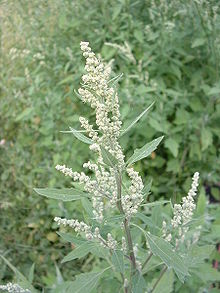- Chenopodiaceae
-
Chenopodiaceae were a family of flowering plants, also called the Goosefoot Family. They are now included within family Amaranthaceae. The vast majority of Chenopods are weeds, and many are salt and drought tolerant. A few food crops also belong to the family: spinach, beets, chard, quinoa, and sugar beets. Chenopod pollen is a common allergen, but most Chenopod crops do not produce pollen.
Taxonomy
Although widely recognized in most plant classifications (notably the Cronquist system), the APG system (1998) and the APG II system (2003) have included these plants in the family Amaranthaceae on the basis of evidence from molecular phylogenies: they are a paraphyletic group, so that for a monophyletic taxon, merger with Amaranthaceae sensu stricto was needed.
Current studies have classified the species of Chenopodiaceae to several distinct subfamilies (Betoideae,[1] Camphorosmoideae,[2] Chenopodioideae,[3] Polycnemoideae, Salicornioideae,[4] Salsoloideae[5] and Suaedoideae[6]).
Pollen allergy
Chenopod pollen is a common allergen. Most species bloom in summer months. Pollen at the microscopic level is mostly indistinguishable from species to species, but cross-reactivity has not been definitively established. Because flowering does not occur in the commercial planting cycle, localized pollen counts will not increase due to planting of Chenopod crops.
References
- APG website: Amaranthaceae
- Allergens in the Chenopod family: [1]
- Chenopodiaceae in L. Watson and M. J. Dallwitz (1992 onwards), The families of flowering plants.
- Flora of North America: Chenopodiaceae
- Flora of China: Chenopodiaceae
- links at CSDL
- Family Chenopodiaceae Flowers in Israel
- ^ G. Kadereit, S. Hohmann & J.W. Kadereit: A synopsis of Chenopodiaceae subfam. Betoideae and notes on the taxonomy of Beta. - Willdenowia 36:9-19, 2006.
- ^ Gudrun Kadereit & Helmut Freitag: Molecular phylogeny of Camphorosmeae (Camphorosmoideae, Chenopodiaceae): Implications for biogeography, evolution of C4-photosynthesis and taxonomy. Taxon 60(1), S. 51-78, 2011
- ^ Gudrun Kadereit, Evgeny V. Mavrodiev, Elizabeth H. Zacharias & Alexander P. Sukhorukov: Molecular phylogeny of Atripliceae (Chenopodioideae, Chenopodiaceae): Implications for systematics, biogeography, flower and fruit evolution, and the origin of C4 Photosynthesis. - American Journal of Botany 97(10): 1664-1687, 2010.
- ^ Gudrun Kadereit, Ladislav Mucina & Helmut Freitag: Phylogeny of Salicornioideae (Chenopodiaceae): diversification, biogeography, and evolutionary trends in leaf and flower morphology. - Taxon 55(3): 617–642, 2006.
- ^ Hossein Akhani, Gerald Edwards, Eric H. Roalson, 2007. Diversification Of The Old World Salsoleae S.L. (Chenopodiaceae): Molecular Phylogenetic Analysis Of Nuclear And Chloroplast Data Sets And A Revised Classification. International Journal of Plant Sciences, 168(6):931–956
- ^ Maxim V. Kapralov, Hossein Akhani, Elena V. Voznesenskaya, Gerald Edwards, Vincent Franceschi, Eric H. Roalson: Phylogenetic Relationships in the Salicornioideae / Suaedoideae / Salsoloideae s.l. (Chenopodiaceae) Clade and a Clarification of the Phylogenetic Position of Bienertia and Alexandra Using Multiple DNA Sequence Datasets. Systematic Botany, 2006.
Categories:
Wikimedia Foundation. 2010.

